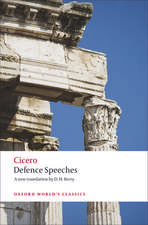The Codex Fori Mussolini: A Latin Text of Italian Fascism: Bloomsbury Studies in Classical Reception
Autor Dr Han Lamers, Dr Bettina Reitz-Joosseen Limba Engleză Paperback – 26 iul 2017
| Toate formatele și edițiile | Preț | Express |
|---|---|---|
| Paperback (1) | 254.55 lei 6-8 săpt. | |
| Bloomsbury Publishing – 26 iul 2017 | 254.55 lei 6-8 săpt. | |
| Hardback (1) | 711.67 lei 6-8 săpt. | |
| Bloomsbury Publishing – 10 aug 2016 | 711.67 lei 6-8 săpt. |
Din seria Bloomsbury Studies in Classical Reception
-
 Preț: 90.70 lei
Preț: 90.70 lei - 14%
 Preț: 180.44 lei
Preț: 180.44 lei - 30%
 Preț: 598.52 lei
Preț: 598.52 lei - 11%
 Preț: 218.91 lei
Preț: 218.91 lei -
 Preț: 90.37 lei
Preț: 90.37 lei - 22%
 Preț: 225.77 lei
Preț: 225.77 lei - 11%
 Preț: 220.75 lei
Preț: 220.75 lei - 30%
 Preț: 540.31 lei
Preț: 540.31 lei - 22%
 Preț: 224.94 lei
Preț: 224.94 lei - 22%
 Preț: 237.75 lei
Preț: 237.75 lei - 30%
 Preț: 597.63 lei
Preț: 597.63 lei - 22%
 Preț: 224.03 lei
Preț: 224.03 lei - 21%
 Preț: 218.74 lei
Preț: 218.74 lei - 21%
 Preț: 218.65 lei
Preț: 218.65 lei - 22%
 Preț: 225.96 lei
Preț: 225.96 lei - 21%
 Preț: 218.47 lei
Preț: 218.47 lei - 30%
 Preț: 569.76 lei
Preț: 569.76 lei - 21%
 Preț: 217.62 lei
Preț: 217.62 lei - 23%
 Preț: 185.19 lei
Preț: 185.19 lei - 20%
 Preț: 219.57 lei
Preț: 219.57 lei - 30%
 Preț: 541.85 lei
Preț: 541.85 lei - 18%
 Preț: 166.36 lei
Preț: 166.36 lei - 30%
 Preț: 569.60 lei
Preț: 569.60 lei - 30%
 Preț: 599.41 lei
Preț: 599.41 lei - 22%
 Preț: 261.08 lei
Preț: 261.08 lei - 22%
 Preț: 260.16 lei
Preț: 260.16 lei - 30%
 Preț: 598.02 lei
Preț: 598.02 lei - 30%
 Preț: 569.70 lei
Preț: 569.70 lei - 21%
 Preț: 218.65 lei
Preț: 218.65 lei - 30%
 Preț: 568.22 lei
Preț: 568.22 lei - 22%
 Preț: 772.98 lei
Preț: 772.98 lei
Preț: 254.55 lei
Preț vechi: 329.66 lei
-23% Nou
Puncte Express: 382
Preț estimativ în valută:
48.71€ • 51.04$ • 40.27£
48.71€ • 51.04$ • 40.27£
Carte tipărită la comandă
Livrare economică 11-25 aprilie
Preluare comenzi: 021 569.72.76
Specificații
ISBN-13: 9781350054868
ISBN-10: 1350054860
Pagini: 152
Ilustrații: 24 bw illus
Dimensiuni: 233 x 156 x 15 mm
Greutate: 0.22 kg
Ediția:NIPPOD
Editura: Bloomsbury Publishing
Colecția Bloomsbury Academic
Seria Bloomsbury Studies in Classical Reception
Locul publicării:London, United Kingdom
ISBN-10: 1350054860
Pagini: 152
Ilustrații: 24 bw illus
Dimensiuni: 233 x 156 x 15 mm
Greutate: 0.22 kg
Ediția:NIPPOD
Editura: Bloomsbury Publishing
Colecția Bloomsbury Academic
Seria Bloomsbury Studies in Classical Reception
Locul publicării:London, United Kingdom
Caracteristici
The first edition of this important literary document of Italian Fascism that makes it accessible to readers with Latin as well as to Classicists
Notă biografică
Han Lamers is Research Fellow at the Humboldt University in Berlin, Germany, and the University of Leuven, Belgium. His research focuses on the Classical Tradition in Early Modern and Modern Europe. He is the author of Greece Reinvented: Transformations of Byzantine Hellenism in Renaissance Italy (2015).Bettina Reitz-Joosse is Assistant Professor of Latin Literature at Groningen University. Her research focuses on the relation between Latin literature and Roman material culture and on Classical Reception in Italian Fascism.
Cuprins
List of IllustrationsAcknowledgementsThe Codex Fori Mussolini in Context1.Introduction2.Structure and Content3.Editions4.The Author of the Codex Fori Mussolini5.The Codex and the Use of Latin under Fascism6.The Codex and the Foro Mussolini7.The Codex under the Obelisk8.The Codex as a Foundation DepositLatin Text and TranslationList of Textual VariantsCommentaryTimelineList of abbreviationsBibliographyIndex
Recenzii
Offers a new element in the mosaic of Latin texts under Fascism and gives back to scholars and cultivated people a forgotten work . The authors offer a detailed edition, translation and commentary of the text and show a not so common knowledge of the complex dynamics of the Italian culture of these years, as the rich bibliography shows. They correctly place in context the composition of this political summary of the most important features of Fascism. Moreover, they explain with the help of a rich and useful set of illustrations the geographical position of the text and of the monuments that host it, while posing interesting questions on the role of this text in reception studies concerning Roman Fascism, placing themselves in the most productive tradition of Realien.
[The authors] are to be congratulated for bringing this interesting document to a wider public. The book has been proofread meticulously ... and is lavishly illustrated.
Stands out as an excellent introduction, not only to Fascist neo-Latin, but to Fascist romanità more generally.
Lamers's and Reitz-Joosse's philological expertise is evident in their critical analysis of the text . and they do an admirable job of situating the Codex in relation to its ancient antecedents, its political setting, and its function within the larger tableau of the Foro Italico . The authors should be commended for bringing this (literally) buried treasure to light, and for the rigor with which they pry it open. This book will be of significant interest to scholars of Fascism and classical reception studies, and could potentially be a valuable pedagogical tool in the classroom, as a concise document of the regime's self-image and its message to the future.
The fascinating product of Lamers's and Reitz-Joosse's laudable efforts to shed much-needed light on the history of this parchment ... I took so much pleasure in re-reading the text with the help of the commentary that I ended up wishing for more.
[The book] will prove valuable for any serious scholar of Fascist romanità. Lamers and Reitz-Joosse have done a great deal of archival work not only on Amatucci's codex, but on many other Latin compositions from the Fascist period, and their bibliography is replete with sources. The book's brevity, along with its clear prose, makes it an appealing text for students as a gateway to understanding Fascist culture from primary source material. Their thorough commentary will allow even those with no Latin background to appreciate the subtle rhetorical strategies of Amatucci's Latin. It will also be of interest to students of Latin prose composition.
This fascinating, excellently researched and richly illustrated volume presents the first modern edition and English translation (with commentary) of a neo-Latin text of 1932, a brief propagandistic history of Italian fascism, which played a central role in Mussolini's self-imaging as a new Augustus and in the configuration of his ambitious architectural complex of the Foro Mussolini at Rome. This revealing account of a forgotten document will be of lively interest to students and scholars of both Italian fascism and classical reception.
This exhaustive and well-written treatment of the Fascist document Codex Fori Mussolini will be of vital interest to anyone concerned with the document itself and with the place it occupies in Mussolini's grandiose attempts to present himself as a successor to the Caesars.
This elegant case study sheds a brilliant new light on the forms and uses of classicism in Fascist Italy. Han Lamers and Bettina Reitz-Joosse show how Mussolini and his followers adopted--and adapted--ancient forms in language, architecture and city planning to legitimate a very modern regime.
[The authors] are to be congratulated for bringing this interesting document to a wider public. The book has been proofread meticulously ... and is lavishly illustrated.
Stands out as an excellent introduction, not only to Fascist neo-Latin, but to Fascist romanità more generally.
Lamers's and Reitz-Joosse's philological expertise is evident in their critical analysis of the text . and they do an admirable job of situating the Codex in relation to its ancient antecedents, its political setting, and its function within the larger tableau of the Foro Italico . The authors should be commended for bringing this (literally) buried treasure to light, and for the rigor with which they pry it open. This book will be of significant interest to scholars of Fascism and classical reception studies, and could potentially be a valuable pedagogical tool in the classroom, as a concise document of the regime's self-image and its message to the future.
The fascinating product of Lamers's and Reitz-Joosse's laudable efforts to shed much-needed light on the history of this parchment ... I took so much pleasure in re-reading the text with the help of the commentary that I ended up wishing for more.
[The book] will prove valuable for any serious scholar of Fascist romanità. Lamers and Reitz-Joosse have done a great deal of archival work not only on Amatucci's codex, but on many other Latin compositions from the Fascist period, and their bibliography is replete with sources. The book's brevity, along with its clear prose, makes it an appealing text for students as a gateway to understanding Fascist culture from primary source material. Their thorough commentary will allow even those with no Latin background to appreciate the subtle rhetorical strategies of Amatucci's Latin. It will also be of interest to students of Latin prose composition.
This fascinating, excellently researched and richly illustrated volume presents the first modern edition and English translation (with commentary) of a neo-Latin text of 1932, a brief propagandistic history of Italian fascism, which played a central role in Mussolini's self-imaging as a new Augustus and in the configuration of his ambitious architectural complex of the Foro Mussolini at Rome. This revealing account of a forgotten document will be of lively interest to students and scholars of both Italian fascism and classical reception.
This exhaustive and well-written treatment of the Fascist document Codex Fori Mussolini will be of vital interest to anyone concerned with the document itself and with the place it occupies in Mussolini's grandiose attempts to present himself as a successor to the Caesars.
This elegant case study sheds a brilliant new light on the forms and uses of classicism in Fascist Italy. Han Lamers and Bettina Reitz-Joosse show how Mussolini and his followers adopted--and adapted--ancient forms in language, architecture and city planning to legitimate a very modern regime.














